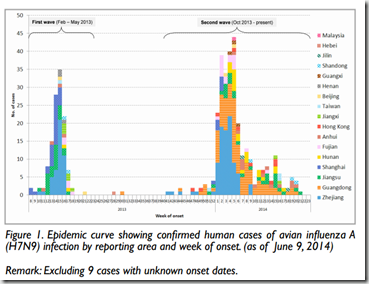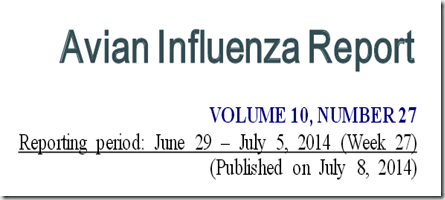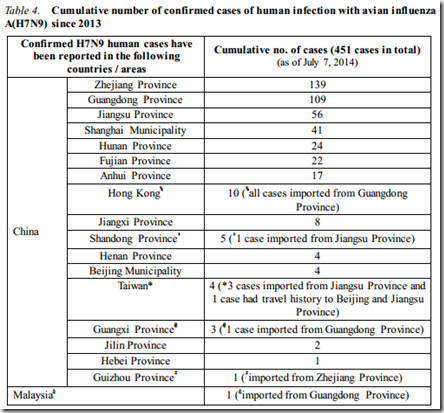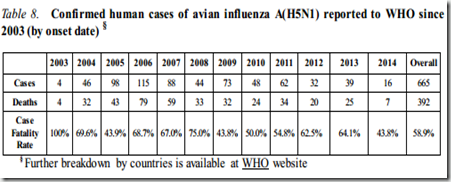Two Waves of H7N9 - Credit Hong Kong’s CHP
# 8810
As the graph above indicates, summer is the `off season’ for avian flu, although sporadic cases occasionally crop up, reminding us that theses viruses continue to circulate in wild birds and poultry. Today, for the first time in more than a week, we’ve a report from Hong Kong’s CHP indicating that they’ve been notified of an addition H7N9 case, this time in Hunan Province.
CHP notified of additional human case of avian influenza A(H7N9) in Mainland
The Centre for Health Protection (CHP) of the Department of Health (DH) received notification from the National Health and Family Planning Commission of an additional human case of avian influenza A(H7N9) affecting a man aged 55 hospitalised in Hunan as of yesterday (July 7).
A total of 436 cases were confirmed in the Mainland, including Zhejiang (139 cases), Guangdong (109 cases), Jiangsu (56 cases), Shanghai (41 cases), Hunan (24 cases), Fujian (22 cases), Anhui (17 cases), Jiangxi (eight cases), Shandong (five cases), Beijing (four cases), Henan (four cases), Guangxi (three cases), Jilin (two cases), Guizhou (one case) and Hebei (one case)."Locally, we will remain vigilant and maintain liaison with the World Health Organization (WHO) and relevant health authorities. Local surveillance activities are ongoing according to the WHO's recommendations," a spokesman for the DH said.
"In view of cases confirmed in the Mainland, further sporadic cases are expected in affected and possibly neighbouring areas. Those planning to travel outside Hong Kong should maintain good personal, environmental and food hygiene at all times," the spokesman urged.
"All boundary control points have implemented disease prevention and control measures. Thermal imaging systems are in place for body temperature checks of inbound travellers. Suspected cases will be immediately referred to public hospitals for follow-up investigation," the spokesman added.
(Continue. . . )
Hong Kong has also published their weekly Avian Influenza Report that adds today’s case to the previous totals.
While it is easy to be lulled by the apparent inactivity of H7N9 in Mainland China right now, the virus continues to spread stealthily among poultry and wild birds, and as it does, it finds new opportunities to mutate and evolve.
Last May, in EID Journal: H7N9 As A Work In Progress, we looked at a study that found the H7N9 avian virus continues to reassort with local H9N2 viruses, making the H7N9 viruses that circulated in wave 2 genetically distinct from those that were seen during the 1st wave.
While late last month, in Eurosurveillance: Genetic Tuning Of Avian H7N9 During Interspecies Transmission, we saw even more evidence of the genetic diversity, and continual evolution, of the H7N9 virus in Mainland China. Researchers found that at least 26 separate genotypes had emerged, mostly during the first wave, through a process they called `genetic tuning’.
As this process appears to be ongoing, with unpredictable results, the authors warned:
Overall, due to the genetic tuning procedure, the potential pandemic risk posed by the novel avian influenza A(H7N9) viruses is greater than that of any other known avian influenza viruses.
Which means that as welcome as this respite in cases may be this summer, come the fall and winter, all eyes will be on the H7N9 virus once again looking for any signs that this avian flu has better adapted to humans.



